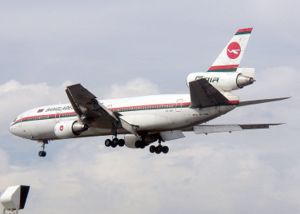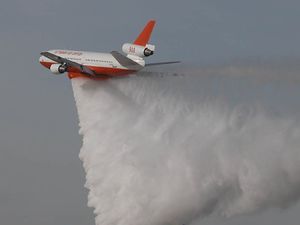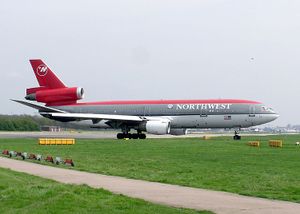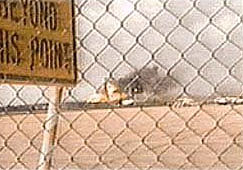PlaneSpottingWorld welcomes all new members! Please gives your ideas at the Terminal.
McDonnell Douglas DC-10
| DC-10 | |
|---|---|
| Ghana Airways DC-10-30 | |
| Type | Airliner |
| Manufacturer | McDonnell Douglas |
| Maiden flight | 1970-08-29 |
| Introduced | 1971-08-05 with American Airlines |
| Primary user | FedEx (89) |
| Produced | 1968-1988 |
| Number built | DC-10: 386 KC-10: 60 |
| Variants | KC-10 Extender |
The McDonnell Douglas DC-10 is a three-engined medium to long-range widebody airliner, with two engines mounted on underwing pylons and a third engine at the base of the vertical stabilizer. The model was a successor to the company's DC-8 for long-range operations, and competed in the same markets as the Airbus A300, Boeing 747 "jumbo jet", and Lockheed L-1011 TriStar, which appears similar to the DC-10.
Production of the DC-10 ended in 1989 with 386 delivered to airlines and 60 to the U.S. Air Force as air-to-air refueling tankers, designated the KC-10 Extender.[1] The DC-10 was succeeded by the related McDonnell Douglas MD-11 which entered service in 1990.
Contents
History
The design of the DC-10 began in 1967.[2] It became McDonnell Douglas's first commercial airliner after the merger between McDonnell Aircraft Corporation and Douglas Aircraft Company in 1967. It was built to a specification from American Airlines for a widebody aircraft smaller than the Boeing 747 but capable of flying similar long-range routes from airports with shorter runways. In some ways, the Boeing 747 was ahead of its time as several smaller airports could not accommodate it because of gate restrictions and runway length. McDonnell Douglas was able to capitalize on this with the DC-10. In particular, the DC-10 trijet design met requirements for NYC's LaGuardia Airport, flying over the Rockies, and flying not transoceanically but at least throughout the Caribbean.
The DC-10 first flew on August 29 1970 and entered commercial service with launch customer American Airlines on August 5 1971 on a round trip flight between Los Angeles and Chicago, nearly a year before the Lockheed L-1011 TriStar (which was built to a similar specification). The launch customers for the DC-10 were American Airlines and United Airlines with orders for 25 and 60 respectively of the Series 10 model.
The first DC-10 version was the "domestic" series 10 with a range of 3800 statute miles (6,112 km). The series 30 had a typical load range of 6,220 statute miles (10,010 km) or a maximum payload range of 7,410 km. The series 40 (mostly ordered by Northwest Orient and Japan Airlines) had a typical load range of 5750 statute miles (9,265 km) or a maximum payload range of 7,520 km. The series 40 was powered by Pratt & Whitney engines, whereas the series 10 and 30 engines were from General Electric. One of the main visible differences between the models is that the series 10 has three sets of landing gear (one front and two main) while the series 30 and 40 have four (3 mains), as an extra 2-wheel main landing gear (which extends from the center of the fuselage) was added to compensate for the extra weight.
The DC-10 was designed with cargo doors that opened outward instead of inward as inward opening "plug-type" doors used on smaller pressurized aircraft. Outward opening doors allowed larger openings required by baggage for a wide-body jet. Outward opening doors rely on a heavy locking mechanism to secure the door against the outward force caused by the pressurization of the fuselage. In the event that the door lock malfunctioned, there was potential for explosive decompression. Following the Turkish Airlines Flight 981 crash in 1974, the cargo door on all DC-10s underwent a mandatory redesign.
Other initial design problems included its lack of locking flap mechanisms designed to maintain their position in the event of a hydraulic or pneumatic failure. The lines from all three independent and redundant hydraulic systems were located in close proximity, directly beneath the tail engine. The MD-11, and later DC-10s incorporated hydraulic fuses to prevent such catastrophic loss of control in event of a hydraulic rupture.
Despite its troubled beginnings, the DC-10 ultimately proved a reliable aircraft, much loved by engineers and pilots. The original DC-10-10's notorious safety record continually improved as design flaws were ironed out and fleet hours increased. In fact, the DC-10's lifetime safety record as of 2003 is comparable to similar second generation passenger jets.[3] Increased inspections and modifications made the DC-10 among the safest aircraft for passenger travel. Nonetheless, because of its poor record in the 1970s, the DC-10 acquired an unfavorable reputation.[4]
The 446th and final DC-10 rolled off the production line in December 1988 and was delivered to Nigeria Airways in July 1989. The DC-10 was assembled at McDonnell Douglas's Douglas Products Division in Long Beach, California.
Variants
The DC-10 was manufactured in a number of different variants:
- DC-10-10 (122 built): Original version, produced from 1970. The customers for this domestic version were American Airlines(35), Continental Airlines(8), Laker Airways(6), National Airlines(11), Turkish Airlines(3), United Airlines(46) and Western Airlines(13). The DC-10-10 was equipped with GE CF6-6 engines, which was the first civil engine from the successful CF6-family.
- DC-10-10CF (9 built): Convertible passenger/cargo transport aircraft. Only built for Continental Airlines(8) and United Airlines(1).
- DC-10-15 (7 built}: Also known as the "DC-10 Sport", designed for use at hot high-altitude airports. The series 15 was fitted with higher-thrust GE CF6-50 powerplants. Only built for Mexican carriers Aeroméxico and Mexicana. Produced from 1979 with 7 built.
- DC-10-20 : Proposed but unbuilt DC-10-10 powered by Pratt & Whitney JT9D turbofans. With minimal airline interest for the original -20, the name was initially recycled to cover the Pratt-powered version of the intercontinental-range DC-10-30. Northwest, one of the launch customers for this longer-range JT9D-powered DC-10 requested the name change to -40 (see -40 entry below).
- DC-10-30 (164 built): The most common model, built with General Electric CF6-50 turbofan engines and larger fuel tanks to increase range and fuel efficiency, as well as a set of rear center landing gear to support the increased weight. It was the second long-range model after the -40 and very popular with European flag carriers. Produced from 1972 to 1988, the DC-10-30 was delivered to 38 different customers, amongst which Lufthansa(11), Swissair(11), VARIG(11), KLM(10) and Iberia(9) were the largest.
- DC-10-30CF (26 built): Convertible cargo/passenger transport version and delivered to Martinair Holland(4), Overseas National Airways(5), Sabena(5), Trans International Airlines(3) and World Airways(9). Sabena was the only commercial operator to fly both cargo and passengers at the same time with its DC-10-30CF.
- DC-10-30ER (6 built): Extended range version. The first aircraft was delivered to Finnair in 1981, followed by Swissair with two aircraft in 1982 and finally Thai Airways International with two in 1987 and one in 1988. The -30ER aircraft have a higher Maximum Take Off Weight of 263,160kg/580,000lb, are powered by three GE CF6-50C2B engines each producing 54,000lb of thrust and are equipped with an additional fuel tank in the rear cargo hold providing an additional 700 miles of range (10,620km/6,600mi/5,730nm). In 1983, United Airlines leased three DC-10-30s from CP Air. These aircraft were modified to -30ER standards to allow the US carrier to fly non-stop on its Seattle-Hong Kong route. When returned to the Canadian operators these aircraft were kept in that version and two more DC-10-30s were converted by Canadian Airlines to extended range specifications.
- DC-10-30F (10 built): All freight version with FedEx as only customer.
- DC-10-40 (42 built): Produced from 1972 to 1982, this was the first long-range version, fitted with Pratt & Whitney JT9D engines. Originally designated DC-10-20, this model was renamed DC-10-40 after a special request from Northwest Orient Airlines for marketing purposes. Northwest Orient felt that customers perceived the -40 series designation to be more advanced. Northwest Orient Airlines and JAL were the only airlines to order the series 40 with 22 and 20 aircraft respectively. The DC-10-40s delivered to Northwest were equipped with three Pratt & Whitney JT9D-20 producing 45,700lb of take off thrust and had a MTOW of 251,815kg/555,000lb, while those produced for Japan Airlines were equipped with P&W JT9D-49A that produced a maximum thrust of 53,000lb and had a MTOW of 256,350kg/565,000lb.
- KC-10A Extender (60 built): Military version of the DC-10-30 used for aerial refueling. The aircraft was ordered by the U.S. Air Force. Produced from 1981. It is the longest-ranged production aircraft in the world.
- KDC-10 (3 built): Aerial refuelling tanker for the Royal Netherlands Air Force. Converted from civil airliners (DC-10-30CF) to a similar standard as the KC-10.
- MD-10: This was retrofit cockpit upgrade to the DC-10 and a re-designation to MD-10. The upgrade included an Advanced Common Flightdeck (ACF) used on the MD-11.[5] The new cockpit eliminated the need for the flight engineer position and allowed common type rating with the MD-11. This allows companies such as Federal Express, which operate both the MD-10 and MD-11, to have a common pilot pool for both aircraft.
- 10 Tanker: A DC-10-10 converted into a firefighting tanker aircraft.
Incidents and accidents
The early DC-10s suffered a trying time during the 1970s when a string of notorious incidents and crashes led to a brief grounding by the United States Federal Aviation Administration.
The outward opening cargo door design problem was first identified in 1972, when American Airlines Flight 96 lost its aft cargo door after takeoff from Detroit, but the crew were able to perform an emergency landing with no further incident. Before Flight 96 took off, an airport employee had forced the door shut, weakening the locking pin and causing the door to blow out as the plane subsequently reached altitude. McDonnell Douglas attempted to place the blame on the employee, whom they described as "illiterate", and deflected criticism of the aircraft design itself.
Although many carriers voluntarily modified the cargo doors and re-trained their ground crews, there was not yet a mandatory redesign of the system. Severe design problems still persisted with the aircraft's cargo doors, and two years after the American Airlines incident, an almost identical cargo door blow-out caused Turkish Airlines Flight 981 to crash into a forest shortly after leaving Orly Airport in Paris on March 3, 1974. 346 people were killed in one of the worst aviation disasters of the twentieth century. The circumstances surrounding this crash were similar to those surrounding the previous accident; however, a modified seating configuration on the Turkish aircraft exacerbated the effects of decompression which caused the floor of the aircraft to collapse into the cargo bay. Vents were not present to allow the pressure between the cargo and passenger compartments to equalize. Control cables running through the floor of the plane were severed when the floor collapsed and this rendered the aircraft uncontrollable. In the aftermath of this crash, all DC-10s underwent a mandatory door redesign.
In 1979, with the cargo door issues resolved, DC-10s (all series) around the world were grounded following the crash of American Airlines Flight 191, which killed 273 people. Flight 191 lost its number one wing engine after taking off from O'Hare International Airport in Chicago, USA, May 25 1979. As the engine separated upwards, it ripped through the leading edge of the wing, rupturing hydraulic lines which caused the port wing slats to retract. As speed was reduced in the climbout, the left wing stalled, the plane rolled left and crashed before the flight crew could recover.
The United States National Transportation Safety Board (NTSB) officials discovered that a maintenance procedure was the culprit: American Airlines mechanics had removed the engine and its pylon at the same time (rather than removing the engine from the pylon then the pylon from the wing, as recommended by McDonnell Douglas), using a forklift, and the forklift operator had inadvertently cracked the pylon in the process. The short-cut procedure, thought to save several man hours on maintenance, was not approved by McDonnell Douglas, but most major airlines used it. Although McDonnell Douglas was not at fault for the pylon separation, it redesigned the DC-10 to allow more redundancies in the hydraulic systems.
The Chicago incident also highlighted a major deficiency in the DC-10 design—its lack of locking flap mechanisms designed to maintain their position in the event of a hydraulic or pneumatic failure. Other widebody aircraft of the day carried such a feature, but it was omitted from the DC-10. Another deficiency highlighted in the NTSB report was the vulnerable placement of electrical wiring at the leading edge (front) of the wing. When the engine pulled up and over the wing, it tore out these electrical wires, thus rendering inoperable vital warning instruments in the cockpit. Other aircraft of this era typically placed this kind of wiring in the center of the wing, in a less vulnerable position.
In 1979, an Air New Zealand DC-10-30 flew into Mount Erebus in Antarctica during a sight-seeing trip. All 257 on board Air New Zealand Flight 901 were killed. The accident was caused by complex factors not related to the airworthiness of the aircraft.
Perhaps the most infamous instance of a DC-10 crash was the Flight 232 disaster at Sioux City, Iowa, USA, in 1989. After the #2 engine (tail engine) suffered an uncontained fan disk failure in flight which ruptured critical hydraulic lines, the crew, led by Captain Al Haynes and assisted by a senior pilot flying as a passenger (Dennis E. "Denny" Fitch), performed an emergency landing by varying remaining engine power to control the plane. Although the aircraft was destroyed with the loss of many lives, the crew flew the aircraft onto the runway in a partially controlled manner and over half of the passengers survived.
The Sioux City crash concerned investigators because the total loss of hydraulic pressure aboard the DC-10 was considered nearly impossible. The design, however, had lines from all three independent and redundant hydraulic systems in close proximity, directly beneath the #2 (tail) engine. Debris from the #2 fan disk separation failure penetrated all three lines resulting in total loss of control to the elevators, ailerons and rudder.
The Air France Concorde crash of 2000 was attributed to a fragment of titanium metal that fell from a Continental Airlines DC-10 that had taken off some four minutes earlier.
Operators
Current operators

The aging model is now largely being used as a dedicated freight aircraft. Many mainline carriers have sold their aging DC-10 fleets to cargo carriers such as FedEx. Some aircraft have been modernized to MD-10s by adding a glass cockpit, which eliminates the need for a flight engineer. Other DC-10 aircraft continue in charter service with their three-person flight deck configurations.
Some passenger airlines, such as Omni Air International, continue to operate the DC-10 on trunk routes. The Royal Netherlands Air Force has converted the aircraft to KDC-10 flying tankers. The Orbis International use a DC-10 as flying eye hospital.
On January 8, 2007 Northwest Airlines retired its last remaining DC-10 being used for scheduled passenger service, replacing it with an Airbus A330 for a route between Minneapolis-St. Paul and Honolulu.[6] Regarding the retirement of Northwest's DC-10 fleet, Wade Blaufuss, spokesman for the Northwest chapter of the Air Line Pilots Association said, "The DC-10 is a reliable airplane, fun to fly, roomy and quiet, kind of like flying an old Cadillac Fleetwood. We're sad to see an old friend go."[7] "The DC-10 is going to be remembered as a better cargo plane than passenger plane," said Richard Aboulafia, an analyst at the Teal Group.[7] In November 2006, ATA Airlines announced they had purchased seven of Northwest's remaining DC-10s, to replace ATA's aging L-1011 airplanes.
At the end of January 2007, fourteen airlines were operating DC-10 aircraft, or about to start operating : Aeroflot, Arrow Air, ATA Airlines, Avient, Biman Bangladesh, Cargoitalia, Centurion Air Cargo, Cielos del Perú, DAS Air Cargo, FedEx, Gemini Air Cargo, Omni Air Interantional, VARIG Logistica and World Airways. FedEx Express being the largest operator with 89 aircraft. All DC-10s remaining in passenger service are series 30 aircraft.
Previous operators
- Aerocancun
- AeroPeru
- AeroLyon
- Aeromexico
- Aerowings
- African Safari Airways
- Air Afrique
- Air Algérie
- Air Europe Italy
- Air Florida
- Air France
- Air Gulf Falcon
- Air Hawaii
- Air Liberté
- Air Mali
- Air Martinique
- Air New Zealand
- Air Outre Mer
- Air Pacific
- Air Siam
- Air Tchad
- Air Zaire
- AirLib
- Airtours International
- Alitalia
- Aloha Pacific
- American Airlines
- American Trans Air
- AOM French Airlines
- Ariana Afghan Airlines
- Arrow Air
- Astra Airlines
- AvCom Commercial Aviation
- Avensa
- Balair
- Biman Bangladesh Airlines
- Birgenair
- Bogazici
- BrasMex Cargo
- British Airways
- British Caledonian
- British Caledonian Charter
- Cal-Air
- Caledonian Airways
- Cameroon Airlines
- Canadian Airlines
- Capitol Air
- Cargo Lion
- ChallengAir
- Challenge Air Cargo
- Condor
- Continental Airlines
- Continental Micronesia
- Corsair
- CP Air
- Delta Air Lines
- Dominicana
- Eastern Air Lines
- Ecuatoriana
- Electra Airlines
- Emery Worldwide Airlines
- European Airlift
- Excalibur Airways
- Express One International
- Finnair
- Garuda Indonesia
- Ghana Airways
- Harlequin Air
- Hawaiian Airlines
- Hawaii Express
- Iberia
- International Red Cross
- JAT Jugoslovenski Aero Transport - now known as Jat Airways
- JALways
- Japan Airlines
- Japan Air Charter
- Japan Air System
- Japan Asia Airways
- Jet Charter Service
- JMC Airlines
- Kenya Airways
- Key Airlines
- KLM - Royal Dutch Airlines
- Korean Air
- Kras Air (Krasnoyarsk Airlines)
- Kuwait Airways
- Laker Airways
- Laker Airways (USA)
- LAN-Chile
- Leisure Air
- Lineas Aereas Paraguayas
- Linhas Aereas de Mocambique
- LOT - Polish Airlines
- Lufthansa
- Malaysia Airlines
- Mandala Airlines
- Martinair Holland
- Mexicana
- Minerve
- Monarch Airlines
- MyTravel Airways
- National Airlines
- Nigeria Airways
- Northwest Airlines
- Novair International Airways
- Okada Air
- Overseas National Airways
- Pacific East Air
- Pakistan International Airlines
- Pan American World Airways
- Philippine Airlines
- PLUNA
- Premiair
- Qantas
- Sabena
- Santa Barbara Airlines
- Saudi Arabian Airlines
- Scanair
- Scandinavian Airlines System
- Scibe Airlift Zaire
- Shabair
- Singapore Airlines
- Skyjet
- Skyjet Brasil
- Skyservice USA
- Sobelair
- Spantax
- STAF Cargo
- Sudan Airways
- Sun Country Airlines
- Swissair
- TAESA
- Taino Airways
- TAROM
- Thai Airways Interantional
- Transaero
- Transamerica
- Trans International Airlines
- Transmile Air Service
- TranStar Airlines
- Tunisair
- Turkish Airlines
- United Airlines
- UTA
- Varig
- Varig Logística
- VASP
- VIASA
- Wardair Canada
- Western Airlines
- Zambia Airways
Specifications
| DC-10-10 | DC-10-15 | DC-10-30 | DC-10-40 | ||
|---|---|---|---|---|---|
| Cockpit Crew | Three | ||||
| Passengers | 250-380 | 250-380 | 250-380 | 250-380 | |
| Length | 182 ft 3 in (55.5 m) | 180 ft 8 in (55 m) | 181 ft 7 in (55.4 m) | 182 ft 3 in (55.5 m) | |
| Height | 58 ft 1 in (17.7 m) | ||||
| Wingspan | 155 ft 4 in (47.3 m) | 165 ft 4 in (50.4 m) | |||
| Operating empty weight | 240,171 lb (108,940 kg) | 266,191 lb (120,742 kg) | 270,213 lb (122,567 kg) | ||
| Maximum take-off weight | 430,000 lb (195,045 kg) | 455,000 lb (206,385 kg) | 572,000 lb (259,459 kg) | 555,000 lb (251,701 kg) | |
| Cruising speed | 600+ mph (965+ km/h) | ||||
| Max Range loaded | 3,800 miles (6,114 km) | 4,350 miles (7,000 km) | 5,860 miles (9,429 km) | 5,750 miles (9,252 km) | |
| Maximum fuel capacity | 21,700 US gal (82,134 L) |
26,647 US gal (100,859 L) |
36,650 US gal (138,720 L) |
36,650 US gal (138,720 L) | |
| Takeoff run on MTOW | 8,612 ft (2,625 m) | 7,257 ft (2,212 m) | 9,341 ft (2,847 m) | 9,242 ft (2,817 m) | |
| Service ceiling | 42,000 ft (12,802 m) | ||||
| Engine model (x 3) | GE CF6-6D | GE CF6-50C2F | GE CF6-50C | PW JT9D-59A | |
| Engine thrust (x 3) | 40,000 lbf (177.9 kN) | 46,500 lbf (206.8 kN) | 51,000 lbf (226.9 kN) | 53,000 lbf (235.8 kN) | |
References
- ↑ McDonnell Douglas DC-10/KC-10 Transport. Boeing. Retrieved on 2006-02-28.
- ↑ "DC-10 History on dc-10.net"
- ↑ "Statistical Summary of Commercial Jet Airplane Accidents (1959-2005)".
- ↑ Hopfinger, Tony (23 October-29 October, 2003). I Will Survive: Laurence Gonzales: 'Who Lives, Who Dies, and Why'. Anchorage Press. Retrieved on 2007-02-09.
- ↑ McDonnell Douglas (1996-09-16). McDonnell Douglas and Federal Express to Launch MD-10 Program. Press release. Retrieved on 2007-02-09.
- ↑ Northwest Airlines (2007-01-08). Northwest Brings Customer Comforts Of Airbus A330 Aircraft To Twin Cities-Honolulu Route. Press release. Retrieved on 2007-02-09.
- ↑ 7.0 7.1 Reed, Ted (2006-06-30). End of an Era at Northwest. TheStreet.com. Retrieved on 2007-02-09.
- McDonnell Douglas DC-10 by Terry Waddington (ISBN 189243704X)
- McDonnell Douglas DC-10 and KC-10 Extender by Arthur A C Steffen (ISBN 1857800516)
- McDonnell Douglas DC-10 by Günter Endres (ISBN 1853109142)
External links
- DC-10 page on Boeing.com
- DC-10 history on Boeing.com
- DC-10 on Aircraft-Info.net
- DC-10 & MD-10 page on Airliners.net
- McDonnell Douglas Trijet Network
- Flight 191 details
- Early DC-10 concept
Related content
Related development
Comparable aircraft
See also
Lists relating to aviation | |
|---|---|
| General | Timeline of aviation · Aircraft · Aircraft manufacturers · Aircraft engines · Aircraft engine manufacturers · Airports · Airlines |
| Military | Air forces · Aircraft weapons · Missiles · Unmanned aerial vehicles (UAVs) · Experimental aircraft |
| Notable incidents and accidents | Military aviation · Airliners · General aviation · Famous aviation-related deaths |
| Records | Flight airspeed record · Flight distance record · Flight altitude record · Flight endurance record · Most produced aircraft |
da:DC-10 de:McDonnell Douglas DC-10 es:McDonnell Douglas DC10 fr:McDonnell Douglas DC-10 id:McDonnell Douglas DC-10 ms:McDonnell Douglas DC-10 nl:Douglas DC-10 ja:DC-10 (航空機) no:McDonnell Douglas DC-10 pl:McDonnell Douglas DC-10 pt:McDonnell Douglas DC-10 ru:McDonnell Douglas DC-10 sr:Мекдонел Даглас ДЦ-10 fi:McDonnell Douglas DC-10 sv:Douglas DC-10 th:แมคดอนเนลล์ ดักลาส ดีซี-10 zh:道格拉斯 DC-10





